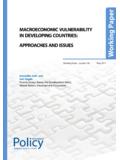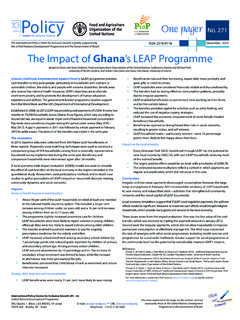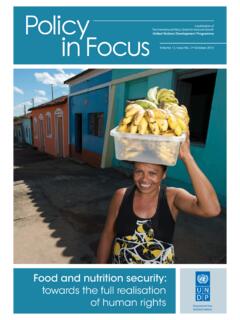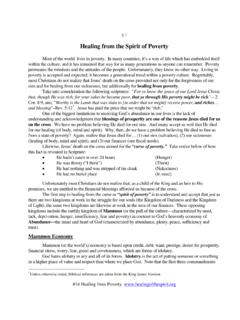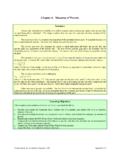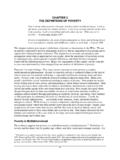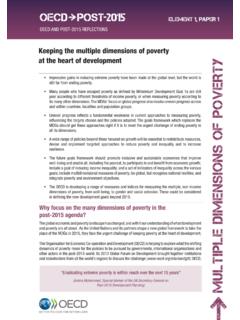Transcription of What is poverty? - IPC IG
1 PovertyInternational poverty CentreUnited Nations Development ProgrammeDecember 2006 what is poverty ?Concepts and measures2 United Nations Development ProgrammeThe international development community has had poverty in focus for more thana decade. At summit meetings and other occasions, world leaders have stated andreconfirmed their agreement that poverty must be reduced and eventually political commitment is a necessary, but not sufficient, condition for this tohappen. Analysts, policy-makers and practitioners need appropriate concepts anddedicated measures to enable progress from rhetoric and general policy statementsto action and results on the this issue of IPC s journal poverty in Focus we present ten articles intended to throwlight on the question of how best to define and measure Chambers outlines five clusters of meanings and reminds us of the importance ofthe analysis and views of poor people themselves and their many meanings.
2 When theyget to express their views, we get a case for changing language, concepts andmeasures in development. The key issue is whose reality counts theirs or ours?Peter Townsend provides an historical perspective of the poverty concept and the settingof poverty lines. Three poverty concepts have evolved, based on ideas of subsistence,basic needs and relative deprivation. Since material needs are socially determined, weneed a new international poverty line based on what is required in different countriesto surmount material and social Fukuda-Parr describes the multidimensional poverty measures developed byUNDP s Human Development Reports since 1990, especially the Human poverty Index(HPI). It shows a large spread of human poverty among countries with similar levels ofincome poverty and thus, HPI is only weakly correlated with income poverty .
3 Recent HPItrends are also presented and Ruggeri Laderchi, Ruhi Saith and Frances Stewart analyse empirical evidence to seeif and why the definition of poverty matters. They also report on field testing in twodeveloping countries of four different approaches. These are shown to have differentimplications for policy and also for targeting, since they identify different causes andeffects of poverty , and different people as being Ranis, Frances Stewart and Emma Samman review the various listings of humanwellbeing and poverty elements, thus identifying a comprehensive set of dimensionsin order to empirically explore whether UNDP s Human Development Index is adequateor needs to be supplemented. They show that assessing human development fullyrequires a broader set of Edward outlines a moral concept of absolute poverty and defines an EthicalPoverty Line derived from globally standardised and ethically justifiable wellbeingindicators.
4 Applying it to actual income data shows that world poverty by a moraldefinition is much larger than by current measures, and so is the required globalincome Meghnad Desai finds the definitions of absolute poverty static, calorific, asocialand atheoretical. He proposes a new poverty line to be based on the need tomaintain individual labour capacities intact, thus connecting to health, nutritionand monetary Kanbur considers the conundrums of measuring poverty when populations changeand analyses three population size scenarios increased, decreased and unchanged, butwith churning around the poverty line. He delivers some remarkable points to Kakwani proposes a multidimensional poverty concept that is causally linked tocommand over economic resources.
5 He argues for an income poverty line that reflectsthe cost of achieving basic human Alkire in response to Kakwani argues that it is not the cause of poverty thatmatters, but what is actionable by public policy. There are many ways to measurecapability deprivation. The debate ends, for now, with a rejoinder by wish you an informative and valuable reading of this issue of poverty in THEEDITORDag EhrenpreisPoverty in Focus is a regular publication of theUNDP International poverty Centre (IPC). Itspurpose is to present the results of research onpoverty and inequality in the developing International poverty Centre (IPC) is ajoint project between the United NationsDevelopment Programme and Brazil to promoteSouth-South Cooperation on applied povertyresearch. It specialises in analysing poverty andinequality and offering research-based policyrecommendations on how to reduce them.
6 IPCis directly linked to the poverty Group of theBureau for Development Policy, UNDP and theBrazilian Government s Institute for AppliedEconomic Research (Ipea).IPC Director (acting)Terry McKinleyEditorDag EhrenpreisInternational Advisory BoardDesktop PublishersRoberto Astorino and Lucas MollFront page: Photo by Fabio Veras, IPC, ofan African cobweb to illustrate both thefragility and the tenacity of the life situationsof people living in or close to conditions ofpoverty. The web metaphor is also applicableto the interlinkages between the variousdimensions of poverty and wellbeing, as in thefigure on page s note: The sources of graphs andtables are the reference publications atthe end of each article concerned. Thanks forpermission to use this material to RobertChambers, Institute of Development Studies,Sussex, UK; UNDP Human DevelopmentReport Office, New York; Journal of HumanDevelopment, Routledge; Third WorldQuarterly, Routledge.
7 And thanks not least toall the authors contributing their time andintellectual products without any Nations Development ProgrammeInternatinal poverty CentreSBS Ed. BNDES, 10 andar70076-900 Brasilia DF content of this publication does notnecessarily reflect the official views of Altimir, CEPAL, Santiago de ChileGiovanni A. Cornia, Universit di FirenzeNora Lustig, UNDP/BDP poverty GroupGita Sen, Indian Institute of Management, BangaloreAnna Tibaijuka, UN Habitat, NairobiPeter Townsend, London School of EconomicsPhilippe van Parijs, Universit de LouvainInternational poverty Centre poverty In Focus December 2006 3 The flood of development rhetoricon poverty , the primacy accorded bylenders and donors to the MillenniumDevelopment Goals, of which the reductionof extreme poverty is the first and usuallyconsidered the most important, and thefrequency with which reducing, alleviatingor eliminating poverty is seen as a primegoal and measure of development these factors make it matter more thanever to know what poverty is.
8 what it istaken to mean depends on who asks thequestion, how it is understood, and whoresponds. From this perspective, it has atleast five clusters of first is income- poverty or its commonproxy (because less unreliable to measure)consumption- poverty . This needs noelaboration. When many, especiallyeconomists, use the word poverty theyare referring to these measures. Povertyis what can be and has been measured,and measurement and comparisonsprovide endless scope for second cluster of meanings ismaterial lack or want. Besides income, thisincludes lack of or little wealth and lackor low quality of other assets such asshelter, clothing, furniture, personalmeans of transport, radios or television,and so on. This also tends to include noor poor access to third cluster of meanings derives fromAmartya Sen, and is expressed ascapability deprivation, referring to what wecan or cannot do, can or cannot be.
9 Thisincludes but goes beyond material lackor want to include human capabilities,for example skills and physical abilities,and also self-respect in fourth cluster takes a yet more broadlymulti-dimensional view of deprivation,with material lack or want as only one ofseveral mutually reinforcing four clusters of the meanings ofpoverty have all been constructed by us , by development are expressions of our education,training, mindsets, experiences andreflections. They reflect our power, asnon-poor people, to make definitionsaccording to our perceptions. And theprimacy we accord to povertyalleviation, reduction or eliminationimplies that these meanings that wegive are fundamental to whatdevelopment should be expression of this has twelvedimensions, each one potentially havingan impact on all of the others, andvice versa, thus emphasising theinterdependence of the dimensions ofpoverty as we see them (see figure below).
10 Another expression of this has fivedimensions to illustrate development asWhat poverty is takento mean depends onwho asks the question,how it is understood,and who common meaningshave all been constructedby us, non-poor reflect our powerto make definitionsaccording toour reality counts?Ours, as we construct itwith our mindsets and forour purposes? Or theirsas we enable themto analyse and express it? what is poverty ?Who asks? Who answers?by Robert Chambers,Institute of Development Studies,Sussex, UK4 United Nations Development Programmegood change. Development thus can beseen as shifting from illbeing to wellbeingwith equity, with interventions toenhance wellbeing possible at any ofthe five points (see figure on the right).But these dimensions are all abstractions,to varying degrees reductionist, based onour analysis and views.



